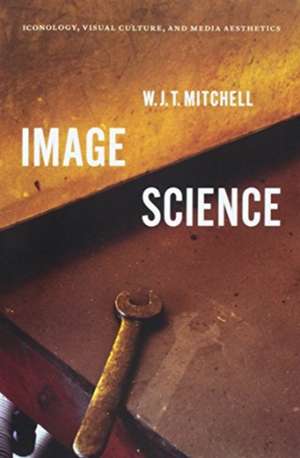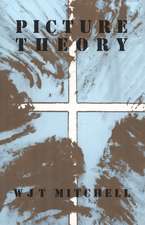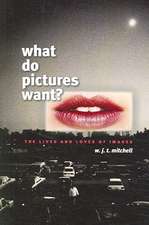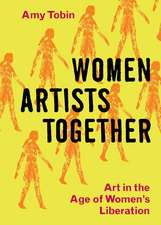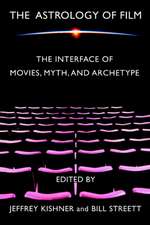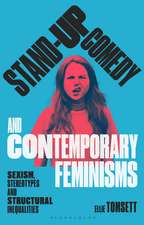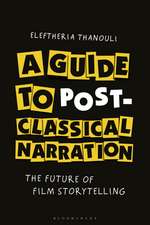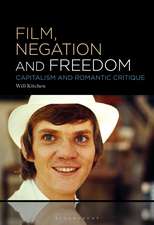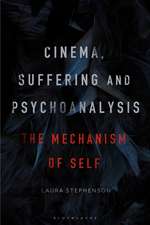Image Science: Iconology, Visual Culture, and Media Aesthetics
Autor Professor W. J. T. Mitchellen Limba Engleză Paperback – 30 ian 2018
Almost thirty years ago, W. J. T. Mitchell’s Iconology helped launch the interdisciplinary study of visual media, now a central feature of the humanities. Along with his subsequent Picture Theory and What Do Pictures Want?, Mitchell’s now-classic work introduced such ideas as the pictorial turn, the image/picture distinction, the metapicture, and the biopicture. These key concepts imply an approach to images as true objects of investigation—an “image science.”
Continuing with this influential line of thought, Image Science gathers Mitchell’s most recent essays on media aesthetics, visual culture, and artistic symbolism. The chapters delve into such topics as the physics and biology of images, digital photography and realism, architecture and new media, and the occupation of space in contemporary popular uprisings. The book looks both backward at the emergence of iconology as a field and forward toward what might be possible if image science can indeed approach pictures the same way that empirical sciences approach natural phenomena.
Essential for those involved with any aspect of visual media, Image Science is a brilliant call for a method of studying images that overcomes the “two-culture split” between the natural and human sciences.
Continuing with this influential line of thought, Image Science gathers Mitchell’s most recent essays on media aesthetics, visual culture, and artistic symbolism. The chapters delve into such topics as the physics and biology of images, digital photography and realism, architecture and new media, and the occupation of space in contemporary popular uprisings. The book looks both backward at the emergence of iconology as a field and forward toward what might be possible if image science can indeed approach pictures the same way that empirical sciences approach natural phenomena.
Essential for those involved with any aspect of visual media, Image Science is a brilliant call for a method of studying images that overcomes the “two-culture split” between the natural and human sciences.
Preț: 185.07 lei
Nou
Puncte Express: 278
Preț estimativ în valută:
35.42€ • 36.84$ • 29.24£
35.42€ • 36.84$ • 29.24£
Carte disponibilă
Livrare economică 24 martie-07 aprilie
Livrare express 08-14 martie pentru 25.34 lei
Preluare comenzi: 021 569.72.76
Specificații
ISBN-13: 9780226565842
ISBN-10: 022656584X
Pagini: 272
Ilustrații: 24 halftones, 4 line drawings, 2 tables
Dimensiuni: 152 x 229 x 20 mm
Greutate: 0.4 kg
Ediția:First Edition
Editura: University of Chicago Press
Colecția University of Chicago Press
ISBN-10: 022656584X
Pagini: 272
Ilustrații: 24 halftones, 4 line drawings, 2 tables
Dimensiuni: 152 x 229 x 20 mm
Greutate: 0.4 kg
Ediția:First Edition
Editura: University of Chicago Press
Colecția University of Chicago Press
Notă biografică
W. J. T. Mitchell is the Gaylord Donnelley Distinguished Service Professor of English and Art History at the University of Chicago and is editor of Critical Inquiry.
Cuprins
List of Illustrations
Preface: Figures and Grounds
Acknowledgments
Part One: Figures
1 Art History on the Edge: Iconology, Media, and Visual Culture
2 Four Fundamental Concepts of Image Science
3 Image Science
4 Image X Text
5 Realism and the Digital Image
6 Migrating Images: Totemism, Fetishism, Idolatry
7 The Future of the Image: Rancière’s Road Not Taken
8 World Pictures: Globalization and Visual Culture
Part Two: Grounds
9 Media Aesthetics
10 There Are No Visual Media
11 Back to the Drawing Board: Architecture, Sculpture, and the Digital Image
12 Foundational Sites and Occupied Spaces
13 Border Wars: Translation and Convergence in Politics and Media
14 Art X Environment
15 The Historical Uncanny: Phantoms, Doubles, and Repetition in the War on Terror
16 The Spectacle Today: A Response to Retort
Coda: For a Sweet Science of Images
Index
Preface: Figures and Grounds
Acknowledgments
Part One: Figures
1 Art History on the Edge: Iconology, Media, and Visual Culture
2 Four Fundamental Concepts of Image Science
3 Image Science
4 Image X Text
5 Realism and the Digital Image
6 Migrating Images: Totemism, Fetishism, Idolatry
7 The Future of the Image: Rancière’s Road Not Taken
8 World Pictures: Globalization and Visual Culture
Part Two: Grounds
9 Media Aesthetics
10 There Are No Visual Media
11 Back to the Drawing Board: Architecture, Sculpture, and the Digital Image
12 Foundational Sites and Occupied Spaces
13 Border Wars: Translation and Convergence in Politics and Media
14 Art X Environment
15 The Historical Uncanny: Phantoms, Doubles, and Repetition in the War on Terror
16 The Spectacle Today: A Response to Retort
Coda: For a Sweet Science of Images
Index
Recenzii
“Mitchell is persistently exciting in the way that he brings images together to build a logical description of a historical situation that is not reductive or simplified. . . . In Image Science, we get a good sense of what he wants the image to do, and some brilliant examples of it, together with an arsenal of semiotic sub-categories.”
“With its comprehensive presentation of Mitchell's revisionist concept of iconology, Image Science serves as an introduction to the challenges of studying both art history and the more innovative fields of visual culture and media studies. It is also a fine review of Mitchell's contributions to interdisciplinary study. . . . Highly recommended.”
“Image Science adds another chapter to Mitchell’s long and illustrious intervention in the disciplines of art history and visual studies. Mitchell argues persuasively for a science of the visual that straddles the humanities and the social and natural sciences, one that addresses not only objects but also their perception and role in human experience. This is an exciting and theoretically challenging collection.”
“Image Science is fascinating and a wonderful account of a leading scholar’s rich research. As always, Mitchell’s writing is erudite, engaging, and challenging; his thinking mindful and provocative in equal measure; his arguments dazzling; his insights startling.”
“Ranging widely across the new visual realities of science, art, cinema, and digital media, these essays are conceptually precise, politically engaged, and deeply reflective. They demonstrate why Mitchell has become America’s leading philosopher of the image.”
